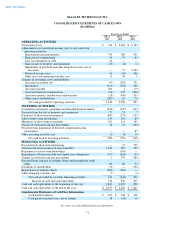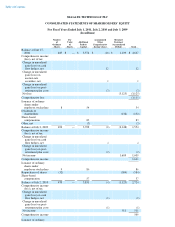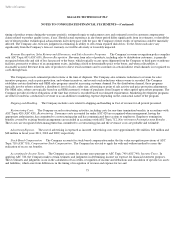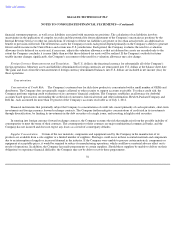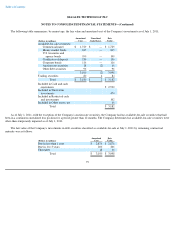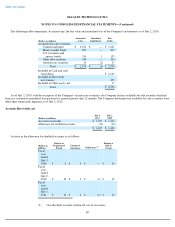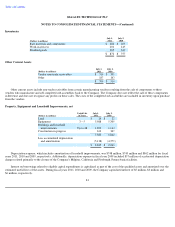Seagate 2010 Annual Report Download - page 83
Download and view the complete annual report
Please find page 83 of the 2010 Seagate annual report below. You can navigate through the pages in the report by either clicking on the pages listed below, or by using the keyword search tool below to find specific information within the annual report.
Table of Contents
SEAGATE TECHNOLOGY PLC
NOTES TO CONSOLIDATED FINANCIAL STATEMENTS—(Continued)
Newly Adopted and Recently Issued Accounting Pronouncements
In June 2011, the Financial Accounting Standards Board (FASB) issued Accounting Standard Update (ASU) No. 2011-05, Comprehensive
Income (ASC Topic 220)
—Presentation of Comprehensive Income. The ASU requires companies to report comprehensive income, including
items of other comprehensive income, for all periods presented in a single continuous financial statement in the Consolidated Statements of
Operations or split between the Consolidated Statements of Operations and a separate Consolidated Statements of Other Comprehensive Income.
The ASU is effective for the Company's first quarter of fiscal year 2013. Other than requiring additional disclosures, the adoption of this new
guidance will not have a material impact on the Company's consolidated financial statements.
In May 2011, the FASB issued ASU No. 2011-04, Fair Value Measurement (ASC Topic 820)—Amendments to Achieve Common Fair
Value Measurement and Disclosure Requirements in U.S. GAAP and IFRSs. The ASU requires additional disclosures about the sensitivity to
changes in unobservable inputs for Level 3 measurements. In addition, for items that are not measured at fair value on the balance sheet but for
which the disclosure of fair values in the footnotes is required, the ASU requires disclosures of the categorization by level within the fair value
hierarchy. The ASU is effective for the Company's first quarter of fiscal year 2013. Other than requiring additional disclosures, the adoption of
this new guidance will not have a material impact on the Company's consolidated financial statements.
In December 2010, the FASB issued ASU No. 2010-29, Business Combinations (ASC Topic 805)—Disclosures of Supplementary Pro
Forma Information for Business Combinations
. The ASU clarifies that pro forma information to be disclosed should be as though the business
combination(s) that occurred during the current year had occurred as of the beginning of the annual reporting period. The ASU is effective for
the Company's first quarter of fiscal year 2012. The adoption of this new guidance will not have a material impact on the Company's
consolidated financial statements.
In January 2010, the FASB issued ASU No. 2010-06, Fair Value Measurements and Disclosures (ASC Topic 820)—Improving Disclosures
About Fair Value Measurements
. The ASU requires new disclosures about transfers into and out of Levels 1 and 2 and separate disclosures
about purchases, sales, issuances, and settlements relating to Level 3 measurements. It also clarifies existing fair value disclosures about the level
of disaggregation and about inputs and valuation techniques used to measure fair value. The new disclosures and clarifications of existing
disclosures are effective for the Company's third quarter of fiscal year 2010, except for the disclosures about purchases, sales, issuances, and
settlements relating to Level 3 measurements, which are effective for the Company's first quarter of fiscal year 2012. Other than requiring
additional disclosures, the adoption of this new guidance did not and will not have a material impact on the Company's consolidated financial
statements.
In October 2009, the FASB issued ASU No. 2009-13, Revenue Recognition (ASC Topic 605)—Multiple-Deliverable Revenue
Arrangements
, a consensus of the FASB Emerging Issues Task Force. This guidance modifies the fair value requirements of ASC subtopic 605-
25, Revenue Recognition-Multiple Element Arrangements by allowing the use of the best estimate of selling price (BESP) in addition to vendor-
specific objective evidence (VSOE) and verifiable objective evidence (VOE) (now referred to as TPE standing for third-party evidence) for
determining the selling price of a deliverable. A vendor is now required to use its best estimate of the selling price when VSOE or TPE of the
selling price cannot be determined. In addition, the residual method of allocating arrangement consideration is no longer permitted. The
Company implemented the provisions of this guidance beginning on July 3, 2010 on a prospective basis for all new or materially modified
arrangements entered into on or after that date. The adoption of this guidance did not have a material impact on the Company's consolidated
financial statements.
77




